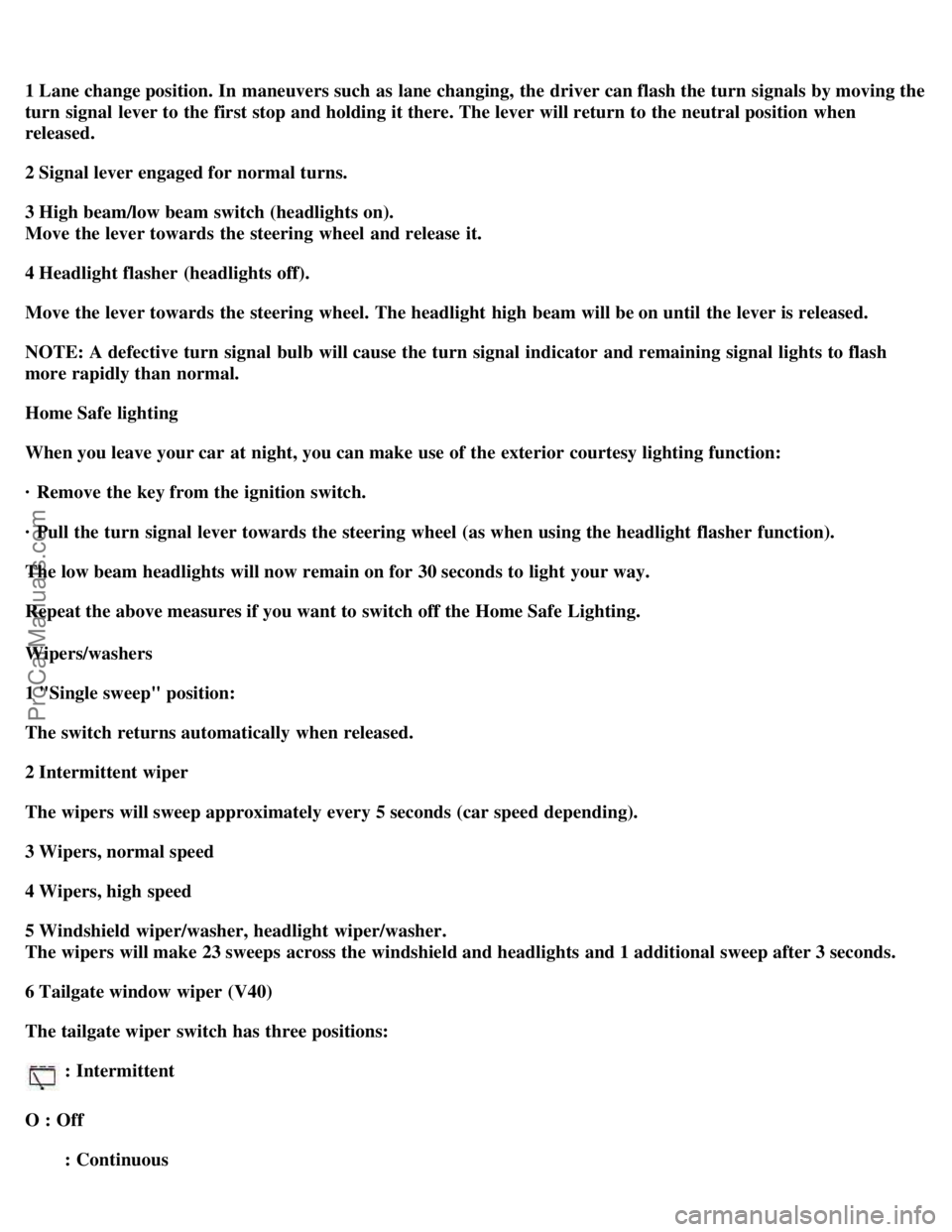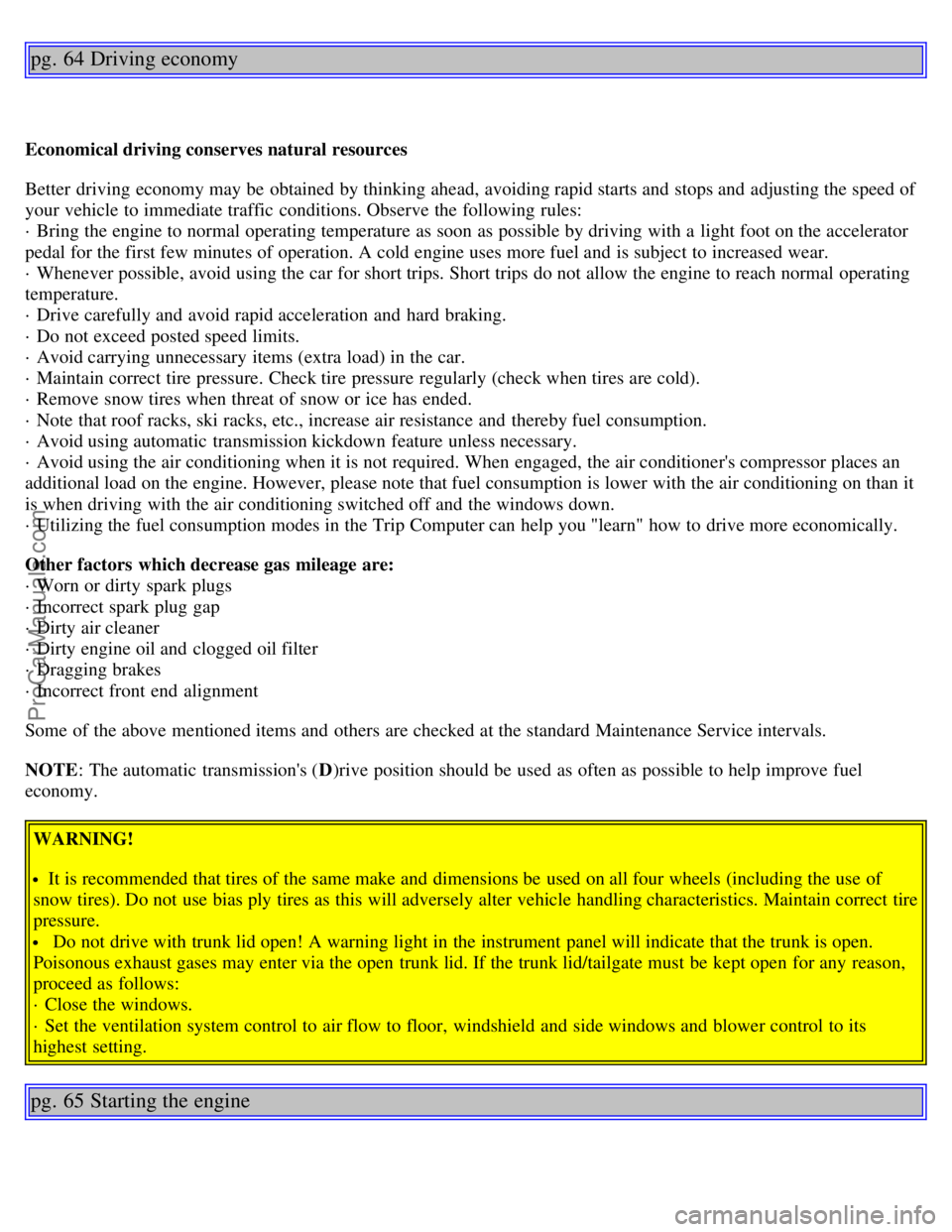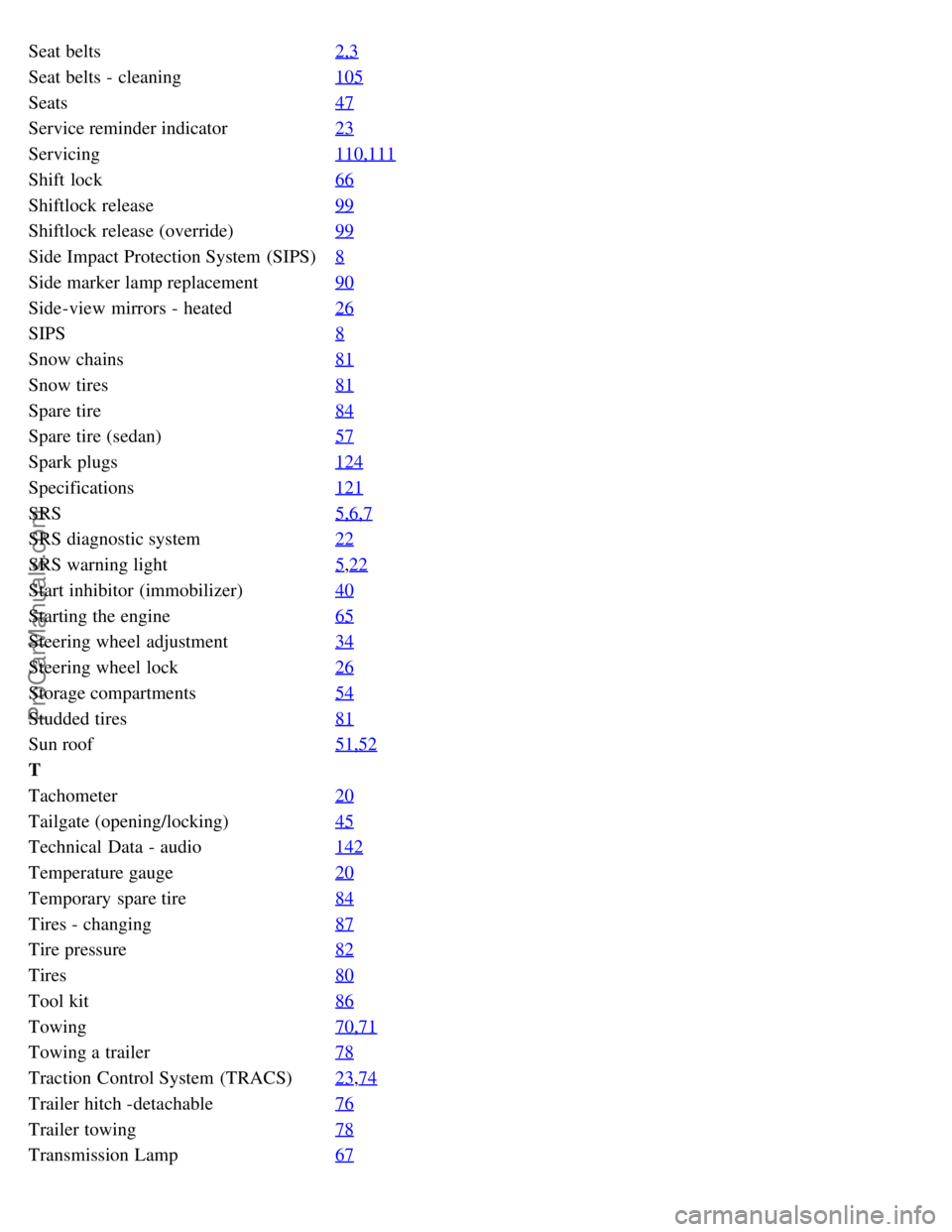tailgate VOLVO V4 2002 Owners Manual
[x] Cancel search | Manufacturer: VOLVO, Model Year: 2002, Model line: V4, Model: VOLVO V4 2002Pages: 88, PDF Size: 2.34 MB
Page 21 of 88

1 Lane change position. In maneuvers such as lane changing, the driver can flash the turn signals by moving the
turn signal lever to the first stop and holding it there. The lever will return to the neutral position when
released.
2 Signal lever engaged for normal turns.
3 High beam/low beam switch (headlights on).
Move the lever towards the steering wheel and release it.
4 Headlight flasher (headlights off).
Move the lever towards the steering wheel. The headlight high beam will be on until the lever is released.
NOTE: A defective turn signal bulb will cause the turn signal indicator and remaining signal lights to flash
more rapidly than normal.
Home Safe lighting
When you leave your car at night, you can make use of the exterior courtesy lighting function:
· Remove the key from the ignition switch.
· Pull the turn signal lever towards the steering wheel (as when using the headlight flasher function).
The low beam headlights will now remain on for 30 seconds to light your way.
Repeat the above measures if you want to switch off the Home Safe Lighting.
Wipers/washers
1 "Single sweep" position:
The switch returns automatically when released.
2 Intermittent wiper
The wipers will sweep approximately every 5 seconds (car speed depending).
3 Wipers, normal speed
4 Wipers, high speed
5 Windshield wiper/washer, headlight wiper/washer.
The wipers will make 23 sweeps across the windshield and headlights and 1 additional sweep after 3 seconds.
6 Tailgate window wiper (V40)
The tailgate wiper switch has three positions:
: Intermittent
O : Off : Continuous
ProCarManuals.com
Page 22 of 88

Tip function
When pressing switch 7 briefly the wiper will make one sweep, independent of the interval
Backing up
When the vehicle is put into reverse with the windshield wipers on and tailgate wiper off, the rear window
wiper will come on for two sweeps.
7 Tailgate window washer (V40)
The washer keeps working for as long as you keep the button depressed.
The wiper will make 2-3 sweeps after the lever is released and 1 sweep after 3 seconds.
Contents | Top of Page
ProCarManuals.com
Page 23 of 88

2 0 0 2
VOLVO
S40 & V40
Chapter 3 - Body and interior
pg. 39 Body and interior
Body and interior
The seats, sun roof, mirrors, etc. are described on the following pages. Keys
40
Remote keyless entry system41
Doors and locks42
Alarm43
Trunk/Tailgate/Glove compartment45
Opening the trunk from the inside (S40)46
Front seats47
Child safety locks49
Rear/side view mirrors/Vanity mirrors50
Interior lights, Sunroof51
Sunroof52
Hood/Luggage cover53
Storage compartments54
Folding rear seat55
Securing carge56
Cargo space/Trunk light, Spare tire, Jack57
Side cargo net, Cargo net58
Weight distribution, Handling, Roadholding, Roof rack59
pg. 40 Keys
ProCarManuals.com
Page 24 of 88

Key
The key activates all locks (ignition switch/steering wheel lock, all doors including the fuel filler door, trunk/tailgate,
and the glove compartment).
Immobilizer (start inhibitor)
Each of the keys supplied with your car is electronically coded. When the key is inserted into the ignition switch, the
code is transmitted to and compared with a code stored in the start inhibitor module. The car can only be started if a
properly coded key is used.
If you misplace a key, take the other keys to an authorized Volvo retailer. The existing code in the start inhibitor
module and all the keys will be erased as an antitheft measure and a new code will be programmed in.
NOTE:
You should never keep more than one of your ignition keys on the ring at the same time. This could cause conflicting
signals to be transmitted to the ignition switch, making it impossible to start the car.
This device complies with part 15 of the FCC rules. Operation is subject to the following condition: (1) This device
may not cause harmful interference, and (2) this device must accept any interference received, including interference
that may cause undesired operation.
pg. 41 Remote keyless entry system
Remote keyless entry system
Your car is equipped with a remote control transmitter. This transmitter uses a radio frequency which will allow
"keyless" entry into the passenger compartment or the trunk. You will be supplied with two coded key ring
transmitters, which will enable you to lock/unlock all doors and the trunk/tailgate and fuel filler door from a distance
of 10-15 feet (3-5 meters).
ProCarManuals.com
Page 25 of 88

The Remote also activates/deactivates the alarm system that comes standard with this car.
The car can also be locked/unlocked with the key.
Using the remote control
· Press the LOCK button once to lock all doors and trunk/tailgate.
· Press the UNLOCK button once to unlock the driver's door and the fuel filler door only. Press this button again
(within 10 seconds) to unlock other doors, trunk/tailgate.
· Press the OPEN trunk/tailgate button to unlock the tailgate/trunk.
NOTE : If only the driver's door is unlocked, the lock will automatically reengage (re-lock) and the alarm will be set
after 2 minutes unless the door has been opened.
The lock/unlock and alarm features can also be utilized by using the keys. See section: Doors and Locks on page 42.
WARNING!
Volvo does not recommend using the transmitter to lock the doors from inside the car. The alarm would be activated
and would sound when one of the doors is opened. The doors must not be locked using the remote transmitter while
the vehicle is occupied. In case of an accident, this may hinder rapid access to the occupants of the vehicle.
Remote control not functioning.
If the remote control is not functioning the car can be started as follows:
Open the driver's door with the key.
Note: The remote control will not function if a key is left in the ignition switch.
FCC ID:LQNP2T-APU
This device complies with part 15 of the FCC rules. Operation is subject to the following conditions: (1) This device
may not cause harmful interference, and (2) this device must accept any interference received, including interference
that may cause undesired operation.
Canadian 2306104388
Model 504 2927 by Donnelly Operation is subject to the following conditions: (1) this device may not cause
interference, and (2) this device must accept any interference, including interference that may cause undesired
operation of the device
Canadian 2306104388A
Model 509 977 by Connaught Electronics Operation is subject to the following conditions: (1) this device may not
cause interference, and (2) this device must accept any interference, including interference that may cause undesired
operation of the device
pg. 42 Doors and locks
Doors and locks
ProCarManuals.com
Page 26 of 88

Your car is equipped with a central locking system.
The key, used on the driver's door, the remote control, or central locking button, will lock/unlock all doors,
trunk/tailgate.
Turn the key once to unlock the driver's door and the fuel filler door.
Turn the key again within 10 seconds to unlock other doors, trunk/tailgate.
One turn with the key towards "lock" in the driver's door locks all doors, trunk/tailgate and fuel filler door with a 10
minutes delay in the fuel filler door.
WARNING!
If the doors are locked while driving, this may hinder rapid access to the occupants of the car in the event of an
accident. (Also see information on "Child safety locks").
Central locking button
Central locking switch
You can use the button to lock or unlock all doors (unlock only for 25 seconds after locking by remote). LEFT side of
button: lock RIGHT side of button: unlock
Note: If the key is in the ignition switch and you close the driver's door, the driver's door will be immediately
unlocked again in order to prevent accidentally locking the car with the keys left inside the car.
pg. 43 Alarm
Alarm
The radio signal emitted from the transmitter, which is used to set/unset the alarm, is a "rolling code" signal. This
means that the signal is changed randomly for each transmission and is intended to help prevent unauthorized
recording of the code.
When armed (set), the alarm continuously monitors a number of points on the car. The following conditions will set off
the alarm:
· The hood is opened
· The trunk/tailgate is opened
· A door is opened
ProCarManuals.com
Page 28 of 88

LED alarm status signals
The status of the alarm system is indicated by the red LED at the right side of the dash:
· LED off - the alarm is not armed (set)
· LED flashes once per second - the alarm is armed (set)
· LED flashes rapidly before the ignition is switched on - the alarm has been triggered
· LED flashes rapidly for 15 seconds after the ignition has been switched on - a fault has been detected in the alarm
system. Contact a Volvo retailer.
Automatic relock
If only the driver's door is unlocked with the remote control, the lock will automatically reengage (re-lock) and the
alarm will be set after 2 minutes unless the door has been opened.
Batteries
Each remote transmitter is powered by two three-volt batteries, type CR 2016. If the range of the transmitter is
noticeably reduced, this indicates that the battery is weak and should be replaced.
Replacement: Open the remote control by twisting a coin in the ring between front and back (leave the ring in place).
Replace the batteries. Reinstall the cover, making sure it is secured tightly.
CAUTION: Do not attempt to service or repair any components of the alarm system yourself. This should only be
done by an authorized Volvo retailer.
pg. 45 Trunk/Tailgate, Glove compartment
Opening/unlocking the trunk/tailgate
ProCarManuals.com
Page 29 of 88

The trunk/tailgate locks are incorporated in the central locking system and are locked or unlocked when the driver's
door is locked/unlocked.
A - Remove key vertically: Trunk/tailgate remains locked (disconnected from the central locking system).
B - Turn key clockwise and remove: Trunk/tailgate are locked/unlocked with the central locking system).
C - Turn key counterclockwise: Insert key and open lock without using central locking system. The key cannot be
removed.
Glove compartment
The glove compartment can be locked with the key.
A unlocked
B locked
Contents | Top of Page
ProCarManuals.com
Page 33 of 88

pg. 64 Driving economy
Economical driving conserves natural resources
Better driving economy may be obtained by thinking ahead, avoiding rapid starts and stops and adjusting the speed of
your vehicle to immediate traffic conditions. Observe the following rules:
· Bring the engine to normal operating temperature as soon as possible by driving with a light foot on the accelerator
pedal for the first few minutes of operation. A cold engine uses more fuel and is subject to increased wear.
· Whenever possible, avoid using the car for short trips. Short trips do not allow the engine to reach normal operating
temperature.
· Drive carefully and avoid rapid acceleration and hard braking.
· Do not exceed posted speed limits.
· Avoid carrying unnecessary items (extra load) in the car.
· Maintain correct tire pressure. Check tire pressure regularly (check when tires are cold).
· Remove snow tires when threat of snow or ice has ended.
· Note that roof racks, ski racks, etc., increase air resistance and thereby fuel consumption.
· Avoid using automatic transmission kickdown feature unless necessary.
· Avoid using the air conditioning when it is not required. When engaged, the air conditioner's compressor places an
additional load on the engine. However, please note that fuel consumption is lower with the air conditioning on than it
is when driving with the air conditioning switched off and the windows down.
· Utilizing the fuel consumption modes in the Trip Computer can help you "learn" how to drive more economically.
Other factors which decrease gas mileage are:
· Worn or dirty spark plugs
· Incorrect spark plug gap
· Dirty air cleaner
· Dirty engine oil and clogged oil filter
· Dragging brakes
· Incorrect front end alignment
Some of the above mentioned items and others are checked at the standard Maintenance Service intervals.
NOTE : The automatic transmission's ( D)rive position should be used as often as possible to help improve fuel
economy.
WARNING!
It is recommended that tires of the same make and dimensions be used on all four wheels (including the use of
snow tires). Do not use bias ply tires as this will adversely alter vehicle handling characteristics. Maintain correct tire
pressure.
Do not drive with trunk lid open! A warning light in the instrument panel will indicate that the trunk is open.
Poisonous exhaust gases may enter via the open trunk lid. If the trunk lid/tailgate must be kept open for any reason,
proceed as follows:
· Close the windows.
· Set the ventilation system control to air flow to floor, windshield and side windows and blower control to its
highest setting.
pg. 65 Starting the engine
ProCarManuals.com
Page 84 of 88

Seat belts2,3
Seat belts - cleaning105
Seats47
Service reminder indicator23
Servicing110,111
Shift lock66
Shiftlock release99
Shiftlock release (override)99
Side Impact Protection System (SIPS)8
Side marker lamp replacement90
Side-view mirrors - heated26
SIPS8
Snow chains81
Snow tires81
Spare tire84
Spare tire (sedan)57
Spark plugs124
Specifications121
SRS5,6,7
SRS diagnostic system22
SRS warning light5,22
Start inhibitor (immobilizer)40
Starting the engine65
Steering wheel adjustment34
Steering wheel lock26
Storage compartments54
Studded tires81
Sun roof51,52
T
Tachometer20
Tailgate (opening/locking)45
Technical Data - audio142
Temperature gauge20
Temporary spare tire84
Tires - changing87
Tire pressure82
Tires80
Tool kit86
Towing70,71
Towing a trailer78
Traction Control System (TRACS)23,74
Trailer hitch -detachable76
Trailer towing78
Transmission Lamp67
ProCarManuals.com